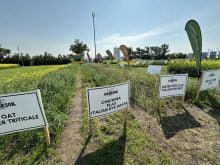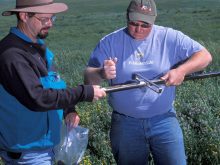By now you’ve heard all about about carbon emissions and climate change. You know that by burning hydrocarbons like oil and coal we humans have been putting CO2 into the atmosphere faster than natural processes can remove it, and that over the rest of this century this will result in more and more extreme weather events.
You may also have heard about climate change mitigation plans like carbon sequestration. In these projects fossil fuel burning power plants would scrub the carbon dioxide out of their emissions and pump them deep underground into depleted oil and gas reservoirs. What you may not realize is that you and every other farmer in the world have been temporarily sequestering megatons of carbon every year, and have been since the beginning of recorded history.
Read Also

Claas brings 1000 Series SP forage harvesters to Canada
In mid-August, Claas unveiled its new line of Jaguar forage harvesters at an event in Visalia, California, deep in the heart of that state’s dairy region.
Kurt Spokas, a soil scientist with the United States Department of Agriculture, believes that farmers not only may play a key role in mitigating climate change, they can improve the health of their fields while they’re at it. Crops absorb enormous amounts of carbon dioxide — an acre yielding 200 bushels of grain can absorb around 19.2 tons in a growing season. The average family car releases six tons in a year of driving, so an acre of high-yield grain sequesters three automobiles worth of carbon. When you think about how much of the mass of a grain is in the stalk and roots, the parts that aren’t eaten by people, that’s a lot of trapped carbon.
In current agricultural practice, all that carbon gets released again. The leftover chaff and other plant matter is often either fed to animals, burned, or decays, which releases the trapped carbon. Spokas and other researchers are investigating ways to trap that carbon more permanently. Their solution: biochar — charcoal made from the low-temperature, low-oxygen burning of organic matter. Charcoal is an excellent trap for carbon, able to hold it for hundreds of thousands of years. Plowed under fields at the end of the harvest, it could do a lot to fight climate change, or at least slow the rise in atmospheric carbon levels.
Producing biochar
Biochar production (by a process called pyrolysis) results in three products: the biochar, syngas, and a liquid called bioil. The syngas can be fed back into the production cycle, lowering fuel costs to produce the charcoal, and the bioil could, with refining, become a useful agricultural fuel. Spokas says we do not yet know enough about the cost of that refining, but it could prove to be a good value added product.
Spokas and his fellow researchers are investigating the effects of biochar on fields. “Unfortunately,” Spokas says, “we do not understand the full mechanisms by which biochar interacts with soils, but there are a few things we know that biochar does.” It decreases the bulk density of soil, adds some nutrients, and increases the alkalinity. There is also evidence it can improve the hydraulic properties of soil, increasing its ability to transport water. On this last point, Spokas says that this transportation may be highly dependent on the original soil texture. It’s not clear that all biochar will improve all soils’ water transport.
While positive results have been seen, Spokas is cautious: “for all of these properties more research is needed, particularly in the longer-term impacts of biochar on soils before guidelines can be established for its widespread use.”
The bill for biochar
While biochar can have real benefits to soil, their magnitude is not understood yet. In addition, another major obstacle to biochar’s adoption is its cost. “Analogous to new prescriptions drugs,” Spokas says, “the costs for biochar are very high due to these initial efforts into producing [it].” He expects that as biochar proves to be a useful soil amendment, production will rise and costs will come down.
Even with only preliminary results about biochars use as a fuel, some climate change activists like James Lovelock are advocating widespread use of biochar as a means of counteracting rising carbon emissions. As the effects of a changing climate become more pronounced, governments around the world may start subsidizing farmers to produce biochar. Though biochar holds a lot of promise for fighting climate change, its high production costs and uncertain benefits mean that, at present, farmers will need to be subsidized to undertake biochar production. However, ongoing research is finding new biochar properties, and it’s an area worth keeping your eye on as a possible future nutrient and fuel source.














